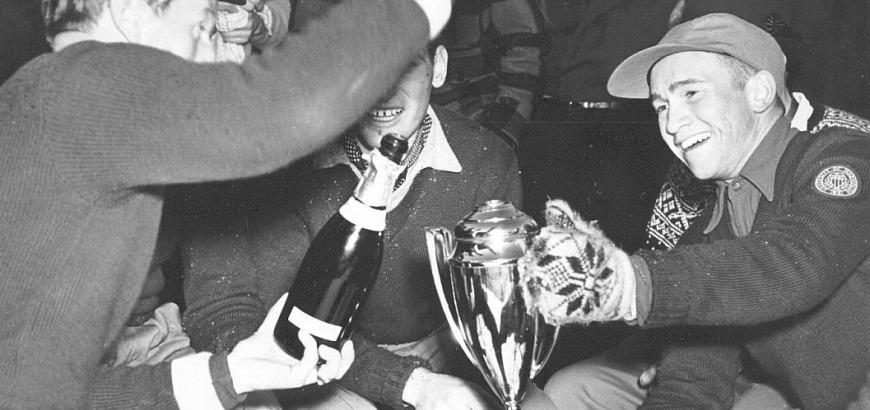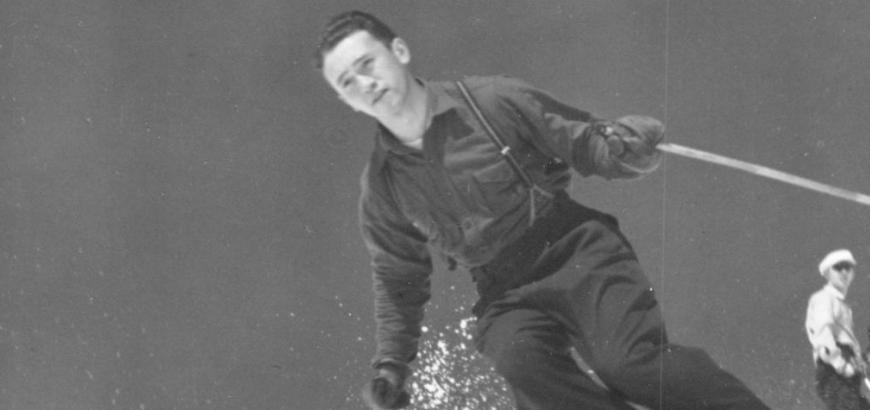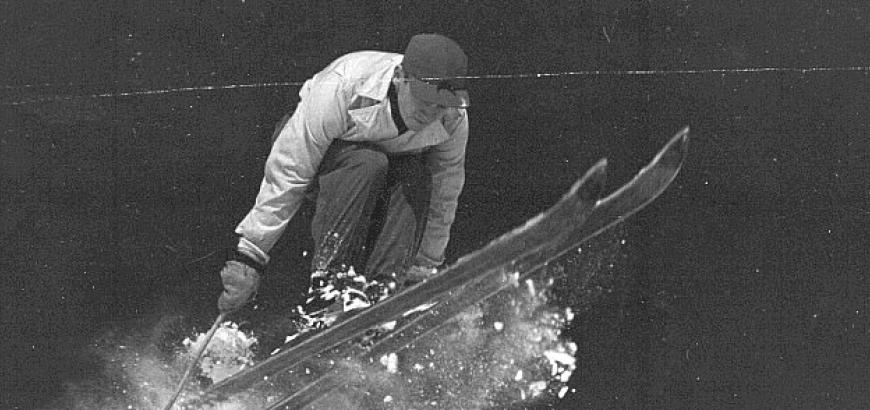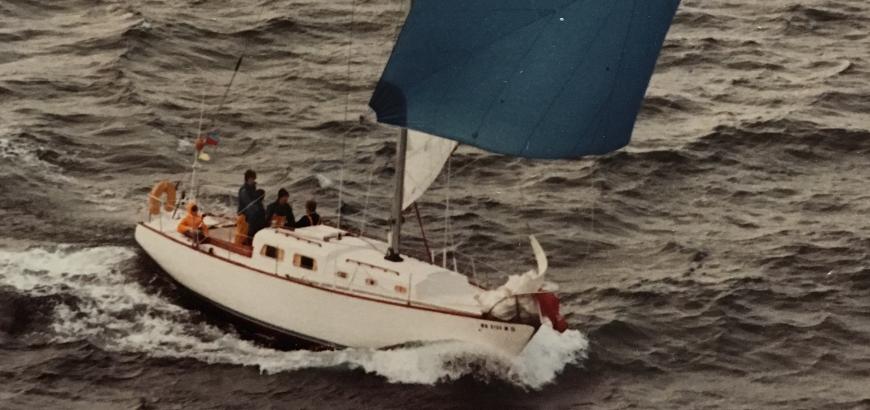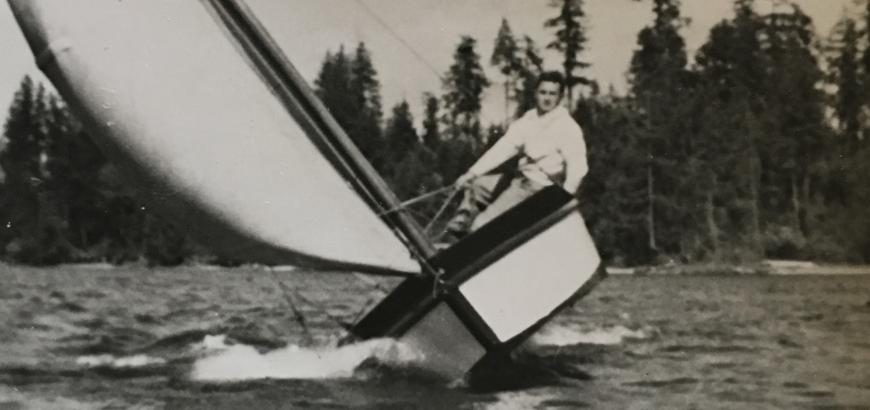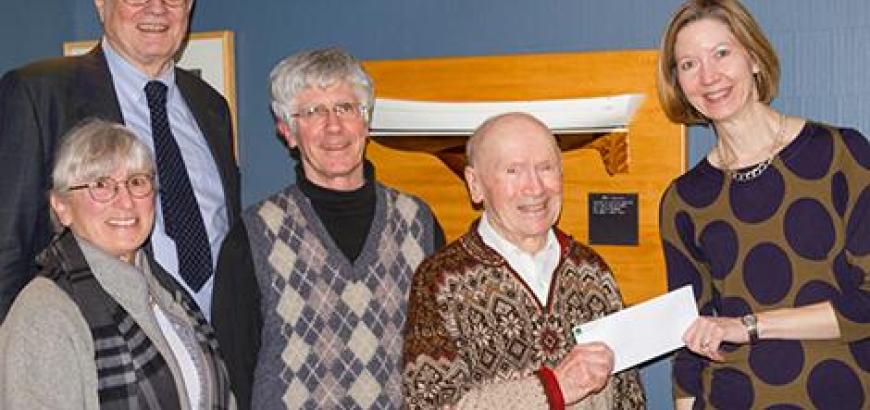Some people’s lives play out like a movie. Lonnie Robinson, University of Washington Class of 1939, is definitely one of those people.
In Act One, 17-year-old Lonnie, after growing up in West Seattle, begins attending the University of Washington in the fall of 1933. At this time, many of Seattle’s streets are still made of dirt. The country is in the midst of the Great Depression and, as Lonnie puts it, “…[it’s] a great time to be a student because there [are] no jobs to be had.”
Majoring in Zoology and minoring in Chemistry, Lonnie drove his Model T Ford—which he purchased for $45 and fixed up—to his classes every day. Quantitative Analysis and Biological Chemistry were among his favorite classes—the latter, in part, because it allowed him to perform laboratory experiments on himself (a practice which he imagines is no longer classroom lab procedure).
Lonnie spent his freshman year playing for the UW hockey team and moved on to the newly formed UW ski team for the next four years. Just like today, college athletes could play four seasons of a sport over five years. Since it was the depression and jobs were scarce, Lonnie stayed for the additional year on the ski team. Skiing in the 1930’s is difficult for current skiers to even imagine: wooden skis with no metal edge to help carve a turn, and no chair lifts to get up the mountainside, let alone ski schools and instructors. Lonnie’s team hiked up the mountain for all their races and learned to ski as a do-it-yourself process. One of Lonnie’s favorite races was the Silver Skis race from Camp Muir to Paradise Lodge on Mount Rainier. The race ran downhill for an ungroomed 3.6 miles with a 5,400 feet total change in elevation. This dangerous event—held from 1934 to 1947—was eventually discontinued due to deaths and injuries on the course.
After four years at UW, Lonnie had completed all the requirements for his major and minor and began to explore classes in Philosophy. He took Introduction to Philosophy with Professor William Savery, who had become the first chair and professor of the philosophy department at its founding in 1902, and for whom Savery Hall is named. Lonnie also took Ethics from Professor Melvin Radar, who was later tried and acquitted of perjury for denying charges of communist activity alleged by the Washington State Joint Fact Finding Committee on Un-American Activities (also known as the Canwell Committee). Lonnie also enjoyed Logic (which would prove extremely useful in his career) and Comparative Religion which broadened his world view. He came to the view that no religion made any more sense than another, that they were all equally valid for their respective cultures, and that they were even key to making a culture successful. These ideas were very different from his family’s view of religion with which he was raised.
Act One finishes with Lonnie graduating from the University of Washington. Act Two opens with Lonnie working in a machine shop, the only work he can find during the depression. He learns about an international student ski competition in Lillehammer, Norway and jumps at the chance to continue skiing competitively.
Lonnie found his way across the ocean working as a dishwasher on a Danish freighter crew, and earned his Danish seaman’s papers. He competed in Europe in 1939 and was in Munich, Germany when the Second World War broke out. While figuring out how to get out of Germany and return home, he helped a University of Munich, Jewish Professor of Jurisprudence get money out of Germany by establishing a working relationship with fake “English Lessons”. He traveled to Switzerland and used an elaborate system of code to exchange and deliver money to friends. After learning that it could be months before he could return home as a regular citizen, Lonnie pulled out his Danish seaman’s papers and found a job working on an American Liberty ship in the galley, to travel from Amsterdam back to New York. Safely back on American soil, he returned to Seattle.
Act Three begins with Lonnie joining the army and entering highly classified radar school.
Radar school was a perfect fit for Lonnie. He was so successful that he became an instructor for the military, teaching radar technology to different bases and universities—including the Pentagon, Langley Field, and MIT. Radar was a new technology and Lonnie was one of the few experts in his field. He was given orders to travel at will to anywhere in the United States where he was needed to teach and test radar, orders unheard of for a first lieutenant. He taught generals and colonels how radar worked and how to best use it. Lonnie explains that radar technology was key to the war effort and helped bring about the end of the war. Radar allowed bombers to accurately hit targets, even in overcast skies, enabling bombers to hide from enemy fire and successfully bomb critical targets such as oil fields in Hungary.
Not only did Lonnie teach others how to use radar, he worked in creating integrated systems to make the radar work. One of the things he had learned from his science classes and philosophy logic class was how to conceptualize entire systems—to integrate, evaluate and assemble things, not just in a piecemeal fashion but as a full concept. He would review several ways of doing things to determine the best and most effective way to proceed. [In the movie version of this story, we see a montage of chalk boards littered with math and demonstrations of systems working and not working in the field. The scene ends with bombers successfully using the system on the Nazis and flying safely back to England.]
After the war, Lonnie returned to Seattle and went to work for Boeing. He raised two children, Jane and Larry, with his wife Alice. Lonnie not only continued to ski race down mountains, he also became an avid sailboat racer, sailing competitively and winning races with his family for years. [Here, the movie fades out with an aerial shot of Lonnie in a regatta with his family on the waters of Puget Sound with the mountains on which he skied visible in the distance.]
However, like all great movies there is a sequel. Lonnie’s story continues with his son Larry Robinson, who completed undergraduate and medical degrees at the University of Washington and was an emergency room doctor for his professional career. We pick Larry’s story up at his retirement. His story is about contemplation, rediscovery, and enlightenment.
Larry took advantage of early retirement and embarked on an outdoor life, spending time backpacking in the summer and ski camping in the winter. He spent around 110 days out of the year in the mountains, usually alone. This much time gave him a different view on life and the land we live in. After five years of enjoying his mountain explorations, his life took a devastating turn when his wife developed breast cancer. The next six years were full of ups and downs, characterized by bad news, miraculous new treatments, and their need to maintain hope. Unfortunately, eventually his wife passed away.
Afterward, Larry found himself unable to hike as often, for many reasons, and decided that he needed to stimulate his brain since he was not “thinking like he used to.” Larry filled this need in the simplest of ways—he looked to the University of Washington public calendar and starting attending lectures and events. He began with the Department of Physics and despite not being able to understand much of the lectures, his interest inspired him to retake college physics classes as an Access student, at first the same ones he had taken 40 years prior. (The Access program allows any Washington state resident age 60 or older to audit one or two university courses per quarter for a small fee.) Struggling through physics problems encouraged him to reach out to other students in the class—these students became his study partners and friends. One of his favorite moments from these study sessions happened when, struggling with some physics problems, his study partner suggested going to the professor’s office to ask for help. Larry had never gone to a professor’s office hours before and did not want to go. However, his friend insisted that the professor was waiting for them to come to his office so that he could help them. It was a defining moment for Larry’s second university education—the realization that professors were happy to talk to him and he was not infringing on their time. Now he advises every student or parent of a student that going to office hours and department lectures are some of the most important parts of a college education.
As he grew comfortable being an Access student, Larry’s class choices became more adventurous. He took a philosophy course in Practical Reasoning from Mitch Kaufman. Prepared by a lifetime of working as an ER doctor and seeing how the world treats disadvantaged people, Larry was primed for Mitch’s radical ideas and ended up taking three courses from him. Larry next tried classes on the History of Science, first from Woody Sullivan. This led him to taking courses in History & Philosophy of Science and Philosophy of Science. Most recently, in reaction to the recent election, Larry took Bill Talbott’s course in Epistemology, in hopes of having a better understanding of what is happening in our world.
Larry’s passion for the History and Philosophy of Science, which studies the theories, methods, practices, and institutions of science from historical and philosophical perspectives, led him to support the Pacific Northwest Workshop for the History & Philosophy of Science. The workshop brought scholars and students from across the Pacific Northwest together to share and discuss their scholarship and research in a full day program free of charge. Lonnie, excited by his son’s enthusiasm for a department of the University he remembers fondly, joined his son in supporting the History and Philosophy of Science Support Fund.
Larry’s story, like his dad’s, is still unfolding. We are excited to see where it goes next and to continue to be a part of it. Larry and Lonnie’s connection to the University of Washington and the Department of Philosophy span over nine decades and inspire us to continue connecting with our students, alumni, and community.

